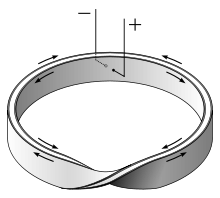Möbius resistor

Current in a Möbius resistor
A Möbius resistor is an electrical component made up of two conductive surfaces separated by a dielectric material, twisted 180° and connected to form a Möbius strip. As with the Möbius strip, once the Möbius resistor is connected up in this way it effectively has only one side and one continuous surface. It provides a resistor that has no residual self-inductance, meaning that it can resist the flow of electricity without causing magnetic interference at the same time.
Patents
- U.S. Patent 4,599,586, Möbius capacitor
- U.S. Patent 3,267,406, Non-inductive electrical resistor
- U.S. Patent 6,611,412, Apparatus and method for minimizing electromagnetic emissions of technical emitters Dietrich Reichwein
References
- "Making Resistors with Math", Time 84 (13), September 25, 1964
- US patent 3,267,406, R. L. Davis, "Non-Inductive Electrical Resistor", issued 1966-08-16
- "Moebius Resistor is Noninductive & Nonreactive", AEC-NASA Tech. Brief (68-10267), 1968
- Hyypia, Jorma (November 1969), "At Ultra-High Frequencies Electronic Components Take On Weird Shapes!", Electronics Illustrated 12 (5): 76, 77, 117